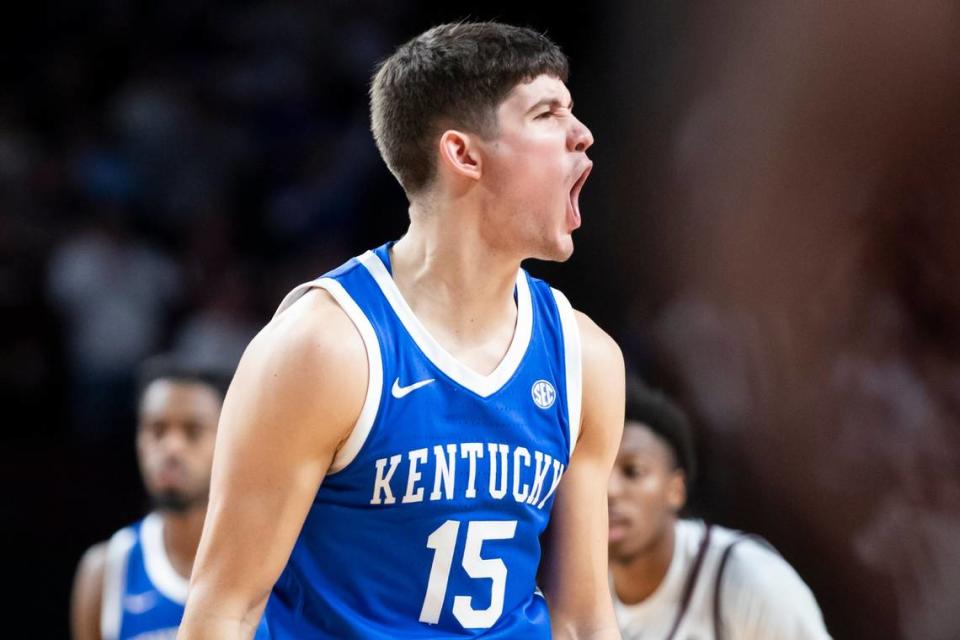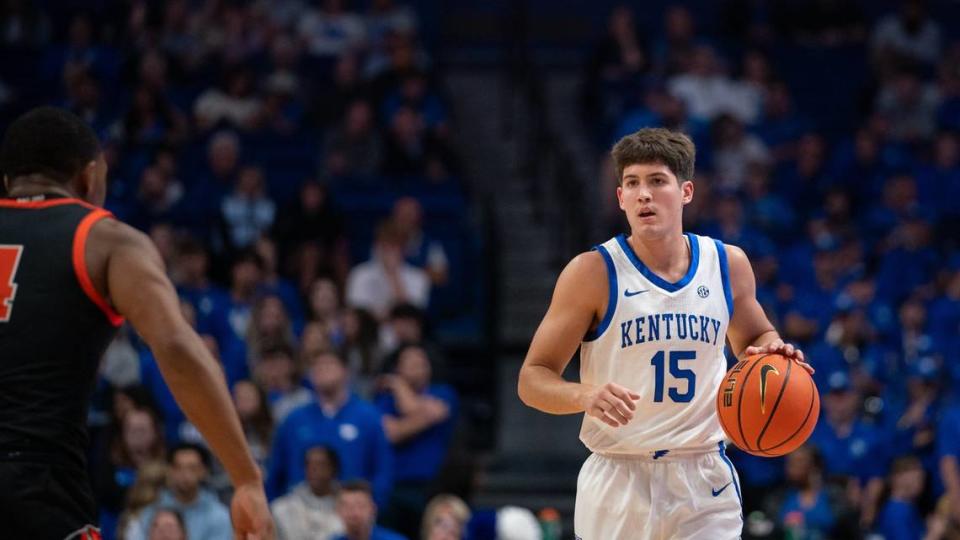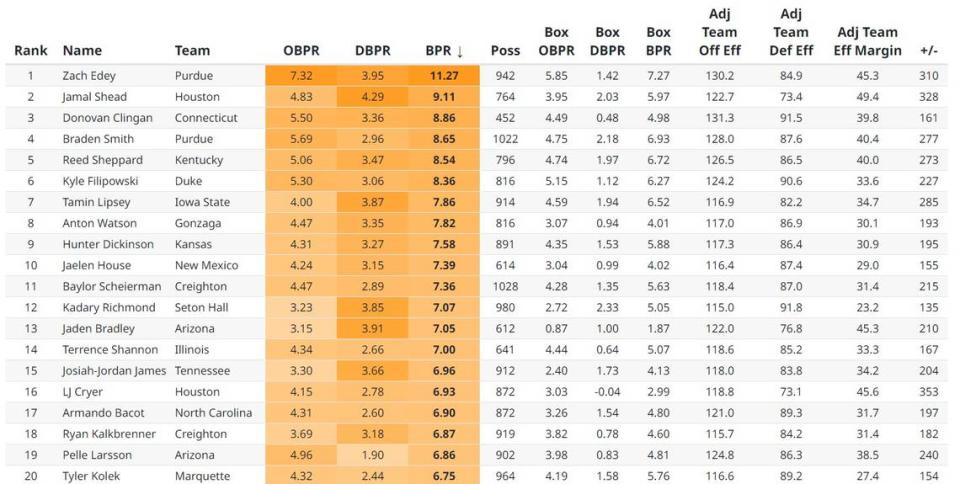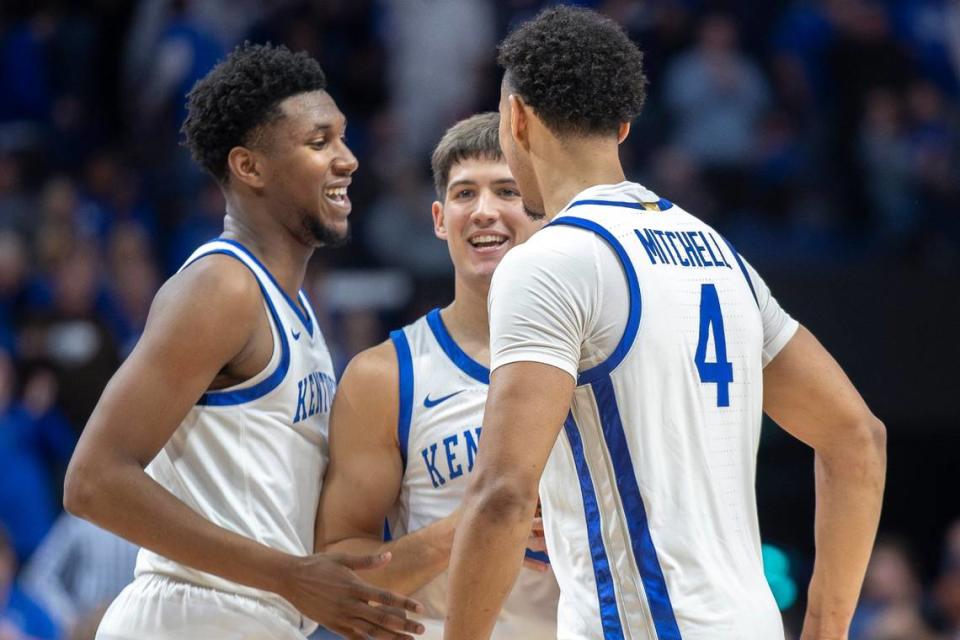Reed Sheppard is one of college basketball’s best players. An analytics expert explains.
There’s a buzz of anticipation that ripples across Rupp Arena whenever he gets up off the bench and trots over to the scorer’s table. There’s a roar of appreciation whenever he checks out of the game and heads back to the sideline.
Halfway through his freshman season, Reed Sheppard is already a Kentucky basketball folk hero. And it hasn’t taken long for the legend to spread beyond the Bluegrass.
Sheppard, the numbers say, is one of the best players in college basketball.
He leads UK with 4.2 assists per game. He leads the SEC with 2.5 steals per game. Sheppard leads the country in 3-point shooting (53.0%) and true shooting percentage, which measures a player’s overall efficiency as a shooter. Most of his stats don’t jump off the page, however. Going into the weekend, he ranked fifth on UK’s team in points. He’s fourth in minutes. He takes the sixth-most shots among the Wildcats. He doesn’t start, much to the chagrin of many in the commonwealth. His game is far from flashy.
But look at any metric, delve deeper into the analytics, and the results border on the unbelievable.
“His numbers are just crazy,” said UK assistant coach John Welch, who spent two decades on NBA sidelines and has the reputation as an innovative basketball thinker. “He has a great feel for the game. And then he’s combining that with elite shooting. And I think he’s just someone that the other players really enjoy playing with. He’s a selfless player out there. And I think he uses his basketball instincts — feel, on both sides of the ball — extremely well.”
Those numbers not only confirm what the eyeballs tell us — that Sheppard is a uniquely gifted and indispensable player for this Kentucky team — but they go even further than that.
Sheppard’s greatness is such that even local fans who have been longing for a homegrown star like him — and have predictably swooned over his every move so far — might not fully understand what they’re seeing.

Reed Sheppard’s BPR
A young Kentucky fan called into John Calipari’s weekly radio show this month with a question. Why wasn’t Reed Sheppard in the starting lineup?
The Hall of Fame coach didn’t seem overly amused. UK play-by-play announcer Tom Leach, the show’s host, couldn’t help but chuckle.
“Richie’s not on the team anymore,” Calipari replied as Leach let out a bigger laugh.
“I meant Reed Sheppard,” the confused caller clarified.
“I know who you meant,” Calipari said with a smile.
More than 30 years after fans across the commonwealth called incessantly to inquire about the playing status of Richie Farmer — another teenaged Kentucky basketball folk hero — UK fans have been doing the same with Sheppard, wanting a bigger role and more minutes for their favorite player.
Calipari explained that he liked the rotation the way it was, with Sheppard and fellow super sub Rob Dillingham entering the game together and giving the Cats an early spark off the bench. The coach said the arrangement wasn’t hurting either player’s NBA draft stock — noting that both were rocketing up those charts even as reserves — and implying that more minutes weren’t the answer for this team’s success or either freshman’s future prospects.
“I know people don’t understand it,” Calipari continued. “But there are people making draft picks that aren’t basketball people. They’re analytics (people). And that’s one of the things that’s helping Reed. Analytically, he’s off the charts. So they look at the numbers and they go, ‘Oh my gosh, we gotta really look at this kid.’”
Evan Miyakawa is one of those “analytics” people who also has a deep understanding of basketball. He’s a statistician, data analyst and the founder of EvanMiya.com, a website dedicated to delving into the numbers of the sport and one often visited by college coaches.
This season, Sheppard’s name has been prominent on the site.
A key metric on EvanMiya.com is the Bayesian Performance Rating (BPR) — a number that represents the ultimate measure of a player’s overall value to his team when he is on the floor.
Obviously, when a player is on the court, he accrues individual stats.
“But the main thing that you’re trying to do is win the basketball game, and the best way to increase your chances of winning a basketball game is by increasing your team’s overall performance while you’re on the floor,” Miyakawa said.
The BPR takes a player’s individual stats on a per-possession basis and adjusts for other variables, such as the quality of the five players he’s playing against and the quality of his teammates at the time he’s in the game.
Most basketball fans are familiar with plus-minus, the simple-as-it-gets formula that states a team’s raw scoring margin when a certain player is on the court. If a player’s team outscores the opponent 55-50 while he’s on the floor, that player would get a plus-5 for that game. The BPR goes way beyond that to try and get a clearer picture of a player’s actual value.
“It kind of takes all of what we want plus-minus to mean, but it addresses a lot of the weaknesses,” Miyakawa said. “Because plus-minus doesn’t have any contextual information. It doesn’t tell you who you played against. It doesn’t tell you how good the other team was or who your teammates are. It also doesn’t have any information about your individual stats, which BPR does. So it really tries to address a lot of those concerns of plus-minus, while still taking the main point of it. … ‘Who’s the most valuable on the floor?’”
By this measure, Sheppard is the most valuable freshman in college basketball. And one of the sport’s best players, period.

Elite company
The morning after Kentucky’s 90-77 victory over Mississippi State on Wednesday night, Sheppard had a BPR of 8.54 on EvanMiya.com. That ranked No. 5 nationally, behind only Purdue’s Zach Edey (11.27), Houston’s Jamal Shead (9.11), UConn’s Donovan Clingan (8.86) and Purdue’s Braden Smith (8.65).
Edey is the reigning national player of the year and runaway favorite to become the first repeat winner of that award in 40 years. Shead is a midseason All-America candidate. Clingan is one of the game’s most dominant players, and Smith would likely be in the thick of the All-America conversation if not for playing in his teammate’s shadow.
The next-best freshman on the list is UConn’s Stephon Castle, at No. 38 nationally.
Limit the player pool to just the SEC — widely regarded as the nation’s No. 2 league behind only the Big 12 — and Sheppard’s standing is even more impressive.
His BPR of 8.54 is noticeably higher than the league’s next-best player: Tennessee senior Josiah-Jordan James at 6.96. In fact, you’d have to go from James at No. 2 all the way down to Auburn’s Aden Holloway at No. 18 to make up the same margin as the gap between Sheppard and James at 1-2.
There are offensive and defensive components that make up a player’s overall BPR. Going into the weekend, Sheppard ranked fourth in the league in offensive BPR and second in defensive BPR. No other SEC player ranked in the top 10 in both categories.
Miyakawa also pointed to the primary metric on his website that he uses for “quantifying the impact on team performance.” It’s called adjusted team efficiency margin.
“Which is basically saying: when that player’s on the floor, how well is the team playing, in terms of outscoring the opposition,” he said.
While breaking down Kentucky’s roster, Miyakawa used Tre Mitchell as an example for comparison. Mitchell’s rating in this category is 26.2, fourth on the team and basically in the middle of the Wildcats’ main rotation. That number means that UK is outscoring opponents by 26.2 points per 100 possessions when Mitchell is on the court and adjusting for an opponent’s strength.
“Which is very good,” Miyakawa said.
Antonio Reeves is next at 26.3. Dillingham is second on the team at 29.3.
Sheppard’s number is 40.0.
“And when you look at that 40 and then you compare it to how well the team is playing without him on the floor, the team is averaging 40 points per 100 possessions better when he’s on the floor,” Miyakawa said. “It’s crazy. And sometimes you’ll have players who are really good in the team efficiency piece but not as good in the box score efficiency piece. And so sometimes there’s a little bit of a give and take there, where it’s like, ‘This player — his stats don’t look great, but when he’s on the floor, the team plays really well.’ Or vice versa. …
“But Reed Sheppard is incredible at both. All the data points to him just being an amazing, really high-impact player, kind of in all facets of the game.”

‘He does all the right things’
For the computing of the BPR, players don’t start a season at zero.
College basketball veterans have past performance data to give them a baseline going into a new season. So, a returning star like Edey would start with a higher number than a role player with past experience. With freshmen, it’s more difficult. Miyakawa said the best measure to start a season there is the consensus recruiting rankings, which he acknowledged can be wrong — often “very wrong” — once the games begin and those players actually start playing.
“And those can be a little bit more biased toward like, ‘What’s your NBA potential?’ Not necessarily, ‘How are you going to impact the college game?’ But that’s kind of the best that we have to go on with making freshman projections,” he said. “So, essentially, how I would get it for Reed is, ‘Here’s the consensus of how he was ranked by recruiting services — how have players with that type of recruiting profile in the past performed in college, in their freshman season?’ And that kind of serves as a starting point for that player.”
Sheppard’s particular starting point — he was the No. 43 overall prospect in the 2023 class, according to the 247Sports composite rankings — makes his meteoric rise all the more impressive, because his BPR number actually started off behind many other newcomers.
Right now, he has the highest BPR for a freshman since Gonzaga’s Chet Holmgren two seasons ago.
“And that’s kind of doing (Sheppard) a disservice, because we all knew Chet Holmgren was going to be amazing,” Miyakawa said. “So I don’t know if I have a player in my database — going back 10-plus years — who has not been hyped to that level and ended up being like a top-10 player in the sport, in terms of on-court value. I don’t think we’ve ever seen a player, at least in recent memory, who’s been a freshman who’s been outside the top 30 or 40 who has this quickly become the most valuable freshman in the sport.”
Holmgren was the No. 1 overall prospect in the 2021 recruiting class and is looking like the best overall player in the 2022 NBA draft class. His ascension in the sport has come as no surprise. Sheppard’s rise has — for most basketball observers — come out of nowhere.
“I think what really sticks out to me is that he does all the right things, and he doesn’t overdo anything or push beyond what he knows he’s capable of,” Miyakawa said. “He always makes decisions that are really smart for the team. And I think that shows up both in his individual stats and in his impact on team performance, which are both really, really good for Kentucky.
“Because, basically, all of the shots he takes are really wise shots. They’re definitely in his bag, but he’s not a volume scorer. Defensively, he’s been really great, despite — I know some people point out that he doesn’t necessarily have the athletic profile of being able to be the best on-ball defender — and yet he’s consistently getting steals and making the right choices defensively. So he knows his limits. And you see that in his individual stats. His individual numbers are really efficient. But then you also look at how well Kentucky is playing with him on the floor, and it’s like night and day difference. It’s pretty crazy.”

Should Reed Sheppard start?
One aspect of Calipari’s radio show response to the question of why Sheppard isn’t in the starting lineup warrants a closer look.
“How ’bout this one. If you play 20, 21, 22 minutes — that’s enough for (an NBA) team to know whether you’re good enough or not,” he said. “You don’t need to play 30, 35, 40. And usually, when you do, those extra five, six minutes hurt you — your efficiency. They’re looking at analytics.”
Sheppard was averaging 26.6 minutes per game following UK’s win over Mississippi State, fourth on the team behind Mitchell (34.4), Reeves (30.3) and D.J. Wagner (27.8). Miyakawa didn’t make a case for Sheppard needing to start — noting that he’s often in the game during crunch time anyway — but playing him more shouldn’t have the negative impact on his own status that Calipari said it might.
Miyakawa acknowledged that there’s a trend with players who jump up in playing time and see their efficiency go down with higher usage. But BPR, he said, is a predictor of value moving forward, and more playing time — in a case like Sheppard’s — should actually reinforce his number as accurate the larger the sample size becomes.
“So, essentially, if Reed were to play more, his BPR should stay the same, theoretically, because even if his efficiency goes down slightly, the model becomes more confident that he’s really as good as what the data is saying,” he said.
Miyakawa advises college coaches to look at the BPR numbers, compare those to their current rotations, and then look at ways in which they could adjust minutes to get the most out of their most productive players.
“Essentially, what this is saying is if you raise Reed Sheppard’s minutes — on a per-possession basis — that’s going to be better for the team than if you keep it the same,” he said. “So the data would suggest that if you play Reed Sheppard more — even if his individual stats go down slightly — his impact on team performance should stay similar. So Kentucky would definitely gain from him playing more.”
Plainly said, the more Sheppard is on the court, the better Kentucky is likely to play.
“If you’re talking about actionable stuff, then I don’t see any reason why Kentucky should be limiting his minutes to what they are,” Miyakawa said. “Because there’s nothing in the data to support that. Because even if his performance level — if he goes up 10 minutes a game — drops slightly, he’s still so far ahead of — not just all other freshmen in the sport, but a lot of other pieces for Kentucky — that there’s no way that’s not going to, at least, from a predictive stance, as of right now, I just don’t really see a way for that not to be a good thing for the team.”
What does Reed think?
While noting that — in a vacuum — giving Sheppard more playing time would be better for Kentucky’s overall performance, Miyakawa acknowledged the realities of the situation and the difficulties of managing a college basketball roster filled with young, talented and ambitious players.
If Sheppard gets more minutes, someone else gets less time on the court. Wagner and fellow freshman Justin Edwards would, seemingly, be the top candidates to cede playing time to Sheppard, but both remain important pieces to this UK team, and both — Edwards, especially — possess untapped potential that Calipari is surely hoping to bring out by March.
And Kentucky’s coach has already started to limit Edwards’ minutes. The freshman — projected by some as the No. 1 pick in the 2024 NBA draft before the season started — has played just 18.5 minutes over UK’s past eight games after averaging 27.7 minutes over the Cats’ first eight games.
Still, Calipari knows that — for this team to reach its maximum potential by March — unlocking more of Edwards’ abilities could be key. Wagner, a similarly touted prospect out of high school, is also the youngest player on Kentucky’s team by four months, and his improvement over the course of the season has been noticeable as he continues to adapt to a higher level of play.
And Calipari has the luxury of trying to figure this out with zero complaints from the player at the center of all this attention. Sheppard has made clear throughout his young basketball career that winning is paramount when he steps on the court. Any mention of personal accolades — whether they be award watch lists or his soaring NBA draft stock — is met with an aw-shucks grin and a comment bouncing the glory back onto those around him.
“At the end of the day, I would not be there if it wasn’t for my teammates and my coaches,” Sheppard said. “My teammates have made this year a lot easier. I can say that everyone on the court can play. So it’s really, really fun playing the way that we’re playing. And they’re making it easy out there — just being able to go and do certain things — because they can do everything else.”
Off the court, Sheppard said his teammates are “like brothers,” always hanging out, talking about basketball and life, a natural chemistry that has led to on-court success. “We’re all really close friends. So I think that plays a role. Big time.”
And those analytics?
“I don’t look at them at all,” he said. “I see them sometimes, but I never get on and look at it. Right now, I’m focused on the season and focused on winning as many games as I can and keep getting better as a team.”
At the mention of the Bayesian Performance Rating, the 19-year-old just grinned.
“Yeah, I have no idea,” he said. “And I don’t want to know. That’s not my job — to figure that out. My job right now is to go out and play basketball and win as many games as I can and do whatever I need to do to win.”
If it’s working, it’s working, he said. Don’t worry about the numbers.
“That’s right. Just keep doing what I’m doing. And keep having fun on the court with my teammates.”

24 to watch in 2024: What will Kentucky basketball sensation Reed Sheppard do next?
Coach K talks up Kentucky basketball (and tells John Calipari about his favorite Wildcat)
Kentucky’s offense put up big numbers in another win. But this one was a little different.
In the lore of UK basketball, Tre Mitchell is putting himself high on an all-time list
After week of carnage in college basketball, where did Kentucky land in the new rankings?
With his UK basketball future on the horizon, Travis Perry has Lyon County dreaming big


